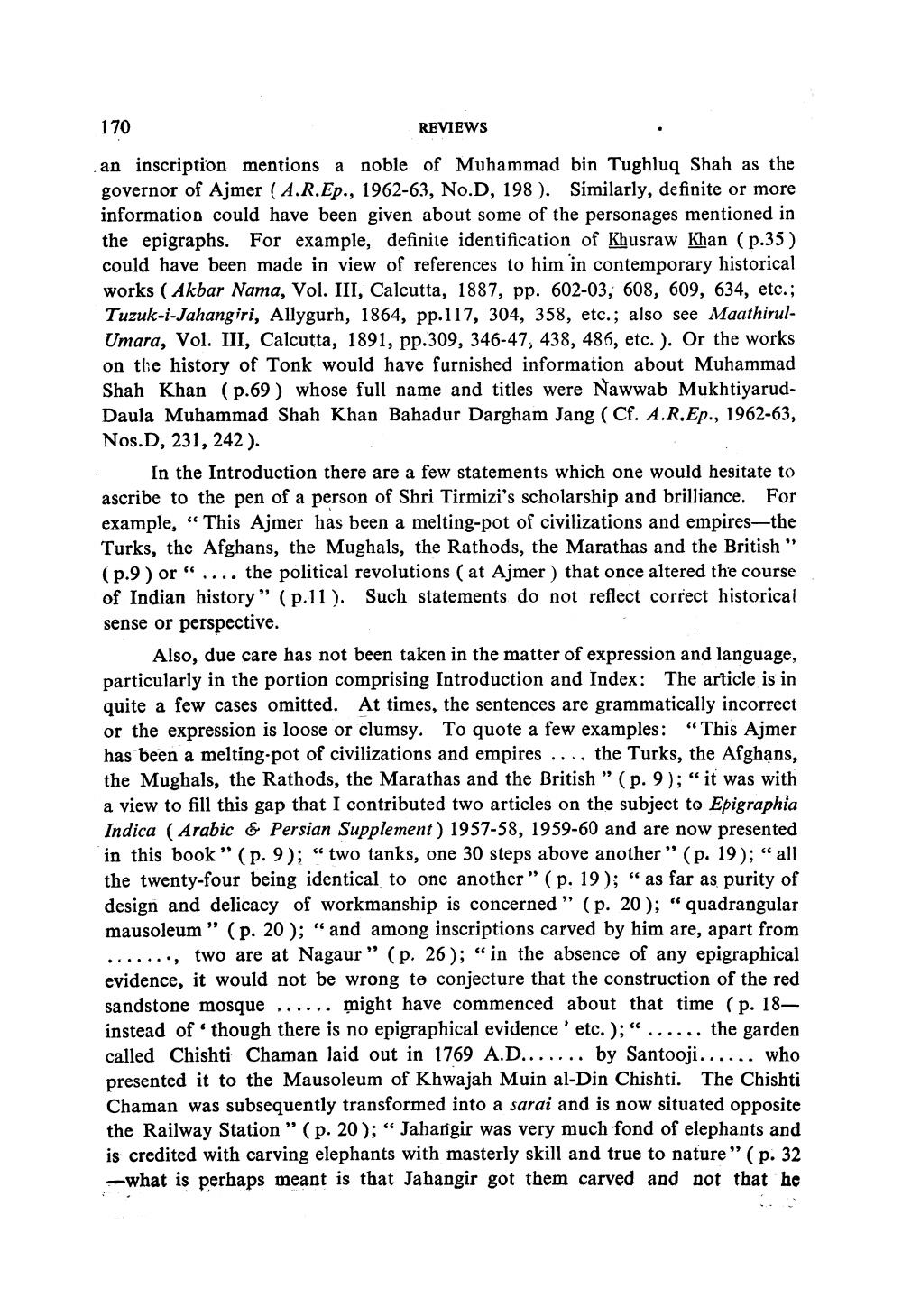Book Title: Reviews Of Studies In Indology Author(s): J S Jetly Publisher: J S Jetly View full book textPage 4
________________ 170 REVIEWS an inscription mentions a noble of Muhammad bin Tughluq Shah as the governor of Ajmer (A.R.Ep., 1962-63, No.D, 198 ). Similarly, definite or more information could have been given about some of the personages mentioned in the epigraphs. For example, definite identification of Khusraw Khan (p.35) could have been made in view of references to him in contemporary historical works ( Akbar Nama, Vol. III, Calcutta, 1887, pp. 602-03, 608, 609, 634, etc.; Tuzuk-i-Jahangiri, Allygurh, 1864, pp.117, 304, 358, etc.; also see MaathirulUmara, Vol. III, Calcutta, 1891, pp. 309, 346-47, 438, 486, etc. ). Or th on the history of Tonk would have furnished information about Muhammad Shah Khan (P.69) whose full name and titles were Nawwab MukhtiyarudDaula Muhammad Shah Khan Bahadur Dargham Jang (Cf. A.R.Ep., 1962-63, Nos.D, 231, 242). . In the Introduction there are a few statements which one would hesitate to ascribe to the pen of a person of Shri Tirmizi's scholarship and brilliance. For example, “This Ajmer has been a melting-pot of civilizations and empires—the Turks, the Afghans, the Mughals, the Rathods, the Marathas and the British" (p.9) or“ .... the political revolutions ( at Ajmer ) that once altered the course of Indian history” (p.11 ). Such statements do not reflect correct historical sense or perspective. Also, due care has not been taken in the matter of expression and language, particularly in the portion comprising Introduction and Index: The article is in quite a few cases omitted. At times, the sentences are grammatically incorrect or the expression is loose or clumsy. To quote a few examples: “This Ajmer has been a melting pot of civilizations and empires ... the Turks, the Afghans, the Mughals, the Rathods, the Marathas and the British " (p. 9); "it was with a view to fill this gap that I contributed two articles on the subject to Epigraphia Indica ( Arabic & Persian Supplement) 1957-58, 1959-60 and are now presented in this book” (p. 9); “two tanks, one 30 steps above another" (p. 19); “ all the twenty-four being identical to one another" (p. 19); "as far as purity of design and delicacy of workmanship is concerned” (p. 20); “ quadrangular mausoleum " (p. 20); "and among inscriptions carved by him are, apart from ......., two are at Nagaur " (p. 26); “in the absence of any epigraphical evidence, it would not be wrong to conjecture that the construction of the red sandstone mosque ...... might have commenced about that time (p. 18— instead of though there is no epigraphical evidence etc.); “ ...... the garden called Chishti Chaman laid out in 1769 A.D....... by Santooji...... who presented it to the Mausoleum of Khwajah Muin al-Din Chishti. The Chishti Chaman was subsequently transformed into a sarai and is now situated opposite the Railway Station” (p. 20); “ Jahangir was very much fond of elephants and is credited with carving elephants with masterly skill and true to nature" (p. 32 -what is perhaps meant is that Jahangir got them carved and not that hePage Navigation
1 2 3 4 5 6 7 8 9
